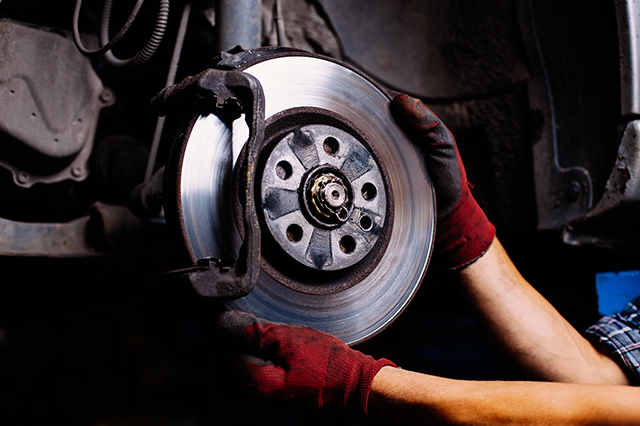Today’s cars have an increasing number of safety features, but there’s one thing that still sits at the top of the list for ensuring you and your loved ones are safe – car brakes. Improvements over the years have made them better and longer-lasting, but if you don’t maintain them properly, then they won’t do their job. Here’s how you can properly take care of your car brakes and know when you need a car brake repair from an experienced professional.
How do car brakes work?
You know they slow you down, but how do they pull off the trick? Your car brakes are made up of multiple parts that work together to slow down your car. Most modern cars use disc brakes on all four wheels. These consist of a plate-like disc (rotor) attached to the wheel, caliper, brake pads, mounting hardware and hydraulics. When you push the brake pedal, that disc is squeezed by the brake caliper, which holds the disc brake pads. Think of your hand grabbing the edge of a spinning plate or how a typical bicycle brake operates. Brake pads are made of a variety of materials that are designed to provide friction and dissipate heat.
The calipers have, depending on the vehicle design, from one to eight pistons that push/squeeze the brake pads against the disc to slow it down. This involves a hydraulic system that pushes brake fluid from the master cylinder to those pistons. When you press on the brake pedal, you’re creating pressure and sending that fluid to the pistons. All of these parts, from the discs to the brake fluid, need to be maintained for your car brakes to work properly.
Check the brake fluid
If the brake fluid is low, it may be due to a leak or the brake pads wearing down. As the brake pads wear, the fluid level will drop in the brake fluid reservoir. If you notice any difference in the operation of your vehicles brakes have the car inspected by a qualified repair shop. You can check your brake fluid to make sure it doesn’t run low or run out, resulting in brake failure. If you are adding brake fluid regularly, there is a leak and it should be checked asap.
Start by checking your owner’s manual to find out where the brake fluid reservoir is located and read the guidelines for checking the brake fluid in your vehicle. Some anti-lock brake systems require pumping the brakes first, so find out if your vehicle has this requirement before you open the reservoir.
Clean the top of the reservoir thoroughly so no dirt gets into the fluid. Dirt can cause your system to fail completely, so make sure absolutely no dirt falls into the reservoir. Once the cap is off, check to see that the fluid level is within about a half inch from the top and add more fluid if it’s too low. Brake fluid absorbs moisture so open the reservoir and fill it quickly rather than letting it sit open. When adding brake fluid always use the proper fluid from a sealed container. Brake fluid attracts moisture. If your spare brake fluid is in an open container, dispose of it and buy new fluid and install the cap when you have topped off the brake fluid.
While it’s open, look at the color of the fluid. If it’s dark, then you should take your car in for service to have the brake fluid replaced. A general guideline is to have it changed once every two years to prevent damaging your car brake system.
While the cap is off of the reservoir, look at the color of the fluid. If it’s dark, then you should take your car in for service to have the brake fluid replaced. New fluid is clear/tan color, contaminated fluid gets darker with age. A general guideline is to have the fluid changed during brake service, although some manufacturer’s recommend fluid changes every two to three years, so check the vehicle’s owner manual.

How long do car brakes last?
How long car brakes last depend on a variety of factors. It’s best to check your brakes roughly every 7,000-10,000 miles to be sure the pads aren’t worn and that the discs and calipers are in good condition.
Worn brake pads announce themselves loudly with a high-pitched screeching sound. That’s the worn brake pad indicator, which is designed to make that noise as a warning. If you hear it, then take your car in to have the brakes checked as soon as possible.
Visually inspect the car brakes
Although you can sometimes see your brakes through the spaces in the wheel spokes, it’s better to remove all four wheels for a closer look. This is a job best done when your car hasn’t recently been driven as brakes get hot and you don’t want to burn your fingers during the inspection.
Safely jack up the car and remove each wheel, so you have a clear view of the disc. A little rust on the disc is OK, but heavy rust requires attention from an experienced service technician. Also look for any uneven wear or scoring on the disc. A professional can tell you if the discs need to be reground or completely replaced. Next, check the calipers. Uneven brake pad wear is an indication of calipers sticking or binding.
Lastly, check out the brake pads. You can see them through the inspection hole which is in the dust shield on the caliper. A mechanic will mount your car on a lift and measure them to ensure they’re not too thin. When they’re roughly a 3-mm thick, then it’s time to have them replaced. If you’re unsure about the thickness of your brake pads, then have a professional inspection.
Lastly, check out the brake pads, a flashlight will help you get a good view. Look at the inside and outside pads. The brake pads can wear differently from left to right, which is why it is important to check all the brakes for wear. At a professional repair shop, a technician will put the car on a lift, inspect not just the brake pads but also look at the brake lines/hose and other brake components. When they’re roughly a 3-mm thick, then it’s time to have them replaced. If you’re unsure about the thickness of your brake pads, have a professional brake inspection.
Car brake maintenance and repair is essential to the safety of both you and other roadway users. Have you ever noticed your brakes not feeling just right? Then it’s time to have them checked.
AAA members can save on automotive replacement parts and accessories at NAPA.
In honor of Car Care Month, AAA members can receive a free “wheels off” brake inspection, tire check, suspension check and tire rotation at a Approved Auto Repair facility all April long.
To learn about the vast array of automotive services AAA provides, click here.














